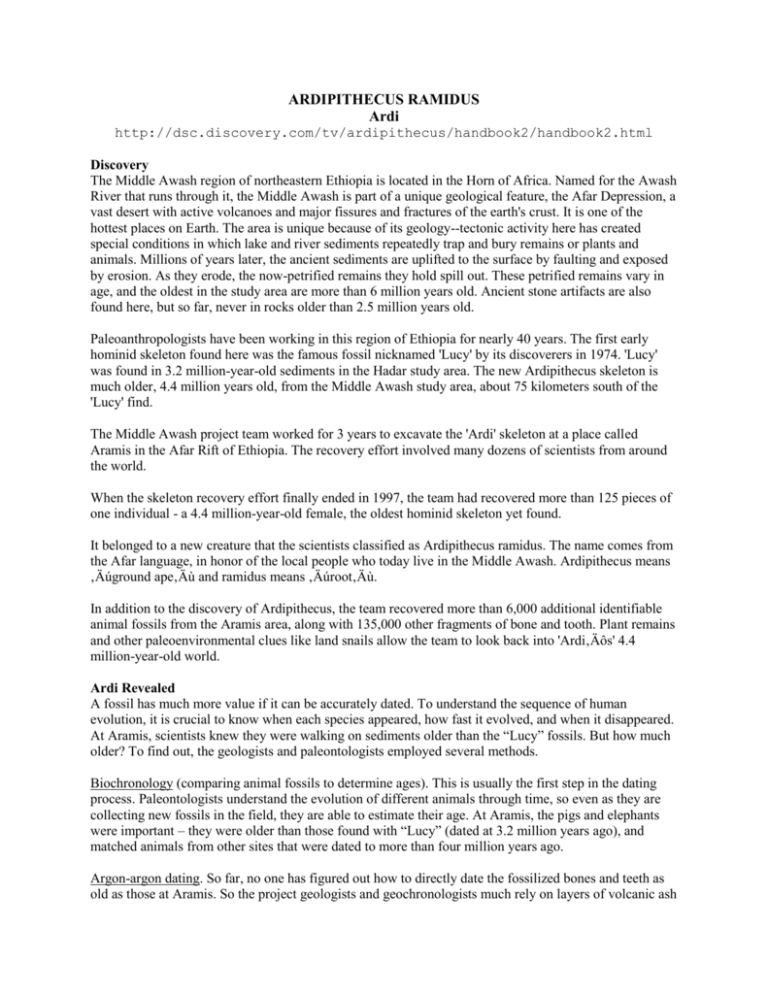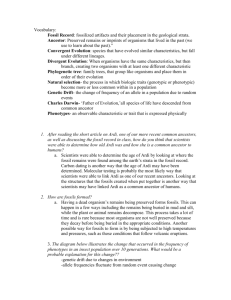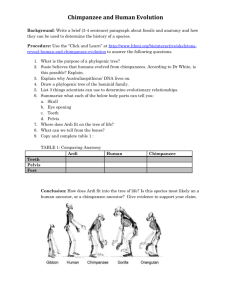Ardi`s skeleton
advertisement

ARDIPITHECUS RAMIDUS Ardi http://dsc.discovery.com/tv/ardipithecus/handbook2/handbook2.html Discovery The Middle Awash region of northeastern Ethiopia is located in the Horn of Africa. Named for the Awash River that runs through it, the Middle Awash is part of a unique geological feature, the Afar Depression, a vast desert with active volcanoes and major fissures and fractures of the earth's crust. It is one of the hottest places on Earth. The area is unique because of its geology--tectonic activity here has created special conditions in which lake and river sediments repeatedly trap and bury remains or plants and animals. Millions of years later, the ancient sediments are uplifted to the surface by faulting and exposed by erosion. As they erode, the now-petrified remains they hold spill out. These petrified remains vary in age, and the oldest in the study area are more than 6 million years old. Ancient stone artifacts are also found here, but so far, never in rocks older than 2.5 million years old. Paleoanthropologists have been working in this region of Ethiopia for nearly 40 years. The first early hominid skeleton found here was the famous fossil nicknamed 'Lucy' by its discoverers in 1974. 'Lucy' was found in 3.2 million-year-old sediments in the Hadar study area. The new Ardipithecus skeleton is much older, 4.4 million years old, from the Middle Awash study area, about 75 kilometers south of the 'Lucy' find. The Middle Awash project team worked for 3 years to excavate the 'Ardi' skeleton at a place called Aramis in the Afar Rift of Ethiopia. The recovery effort involved many dozens of scientists from around the world. When the skeleton recovery effort finally ended in 1997, the team had recovered more than 125 pieces of one individual - a 4.4 million-year-old female, the oldest hominid skeleton yet found. It belonged to a new creature that the scientists classified as Ardipithecus ramidus. The name comes from the Afar language, in honor of the local people who today live in the Middle Awash. Ardipithecus means ‚Äúground ape‚Äù and ramidus means ‚Äúroot‚Äù. In addition to the discovery of Ardipithecus, the team recovered more than 6,000 additional identifiable animal fossils from the Aramis area, along with 135,000 other fragments of bone and tooth. Plant remains and other paleoenvironmental clues like land snails allow the team to look back into 'Ardi‚Äôs' 4.4 million-year-old world. Ardi Revealed A fossil has much more value if it can be accurately dated. To understand the sequence of human evolution, it is crucial to know when each species appeared, how fast it evolved, and when it disappeared. At Aramis, scientists knew they were walking on sediments older than the “Lucy” fossils. But how much older? To find out, the geologists and paleontologists employed several methods. Biochronology (comparing animal fossils to determine ages). This is usually the first step in the dating process. Paleontologists understand the evolution of different animals through time, so even as they are collecting new fossils in the field, they are able to estimate their age. At Aramis, the pigs and elephants were important – they were older than those found with “Lucy” (dated at 3.2 million years ago), and matched animals from other sites that were dated to more than four million years ago. Argon-argon dating. So far, no one has figured out how to directly date the fossilized bones and teeth as old as those at Aramis. So the project geologists and geochronologists much rely on layers of volcanic ash to “bracket” the age of fossil-bearing sediments. By dating the rocks, they date the fossils above (younger) and below (older). Argon-Argon dating is the technique they use to measure elapsed time since the eruption that produced the volcanic ash or lava. When volcanoes erupt ash or lava flows that cover the landscape, the argon gas contained in the molten material is boiled off because of the intense heat of the eruption. After the ash or lava cools, the radioactive component of the element potassium decays at a known rate (called a half life) to form argon gas. The gas remains trapped in the rock or minerals. Geologists sample the volcanic rocks, take them to the lab where they are melted with a laser to extract the argon gas, and then use a mass spectrometer to measure the amount of argon gas trapped inside. If the argon gas is not a contaminant, the more gas there is, the older the rock. At Aramis, geologists sampled the two volcanic layers that sandwiched the sediments with the “Ardi” fossils and established precise dates for the volcanic layers: 4.419 (below) and 4.416 (above million years. Tephrachemistry Any volcano's magma chamber contains a unique mix of chemicals. Each time it erupts, the ash that settles on the surrounding landscape (sometimes thousands of miles away, depending on the size of the ash cloud and the wind direction) contains the same diagnostic geochemical "fingerprint." These geochemical fingerprints allow scientists to match outcrops of volcanic ash at each fossil locality scattered across the modern eroding landscape. Once a volcanic ash is characterized, it is dated (if possible) by the Argon-Argon method (see above). With a date established for any one outcrop of the volcanic horizon, all the scientists have to do to determine the age of the volcanic rocks they find is match the fingerprint to make the correlation. By doing this, the precise dates could be applied to all the collected fossils. The 'Ardi' skeleton was found in one small patch of sediments at Aramis that was named Locality 6 (the partial hominid skeleton is fossil number ARA-VP-6/500, the five-hundredth catalogued fossil from that patch called Aramis Locality 6). Other plant and animal fossils were found in the same horizon as the skeleton. By using geochemical fingerprinting, the team geologists were able to match the volcanic ash layers above and below the fossil horizon at this locality with those from numerous other localities scattered across many kilometers. This told them that the 6,000+ fossils recovered at Aramis between these two volcanic horizons gave a snapshot of a world that was 4.4 million years old. Paleoenvironment Over a 17-year period, the research team recovered more than 150,000 plant and animal fossils, finally classifying more than 6,000 bones and teeth at the level of “Family” or below in the taxonomic hierarchy. The fossils show that 4.4 million years ago, Aramis was dominated by humid woodlands inhabited by leaf-eating monkeys, spiral-horned antelopes, pigs, rhinos, elephants, aardvarks, giraffes, horses, birds, fish, bats, lizards, shrews, many kinds of rodents, and one hominoid species, Ardipithecus. Fossil wood, seeds, pollen, and geological samples indicate that Aramis was lush woodland on a broad flat plain that was occasionally inundated when heavy rains flooded rivers over their banks. For years, scholars have debated the nature of the environment in which the earliest hominids evolved: some favored open habitats, like the modern day savannas (open grasslands) or Africa. Others have suggested that the first hominids evolved in open woodlands adjacent to savannas. The discovery of Ardipithecus and the world of Aramis show that at least some proto-hominids were living in dense woodlands, and her anatomy demonstrates that she was well adapted to moving through this habitat in several ways. Ardi’s skeleton The skeleton includes many important bones of the hands, feet, limbs, and pelvis. Most of the skull with its teeth was preserved, but it had been broken and scattered before burial. These fossil bones offer key insights into how 'Ardi' was built, and how she moved. 'Ardis' skeleton demonstrates that she was a creature capable of both walking upright and clambering through trees with a grasping big toe, in a way unlike any other creature known to science. The skull and teeth. Ardi’s little-worn third molar suggests that she was a young adult when she died. Her brain was small, about the size of a chimpanzee’s. Her canine was the smallest of her species, so it’s likely that she was a female. The male and female canines were much smaller and differently shaped than those in any living or fossil ape. And the construction and chemical composition of the teeth show that they ate foods available in a woodland habitat rather than those found in savannas. The pelvis. Even though badly damaged, the pelvis offers much insight into how “Ardi” moved. Most of its more important characters are reasonably well-preserved. Some of its muscle attachments and shape in the upper pelvis are more like those of an upright walking human than of a knuckle=walking chimpanzee, but the lower pelvis is more primitive than known from any known true hominids (like “Lucy”). Among the most interesting contrasts are the differences between the upper pelvis (the ilium) and the lower pelvis (particularly the ischium). The upper pelvis indicates a substantial adaptation to upright walking. The lower pelvis shows retention of attachment sites for large muscles used in climbing. These would have made the lower limb quite massive and would have limited Ardi’s speed and agility when on the ground – but this is one the evolutionary trade-offs that the species made to be a biped who retained significant climbing ability. The hand. The Ardi skeleton preserves almost all of the hand bones. The bones in the palm of her hand are short, but her finger bones are long. This is neither an ape hand nor a human hand, but something unique. Her wrist bones show that she did NOT walk on her knuckles like chimps and gorillas. They also show that her hand could be placed in a variety of positions that would have made climbing relatively easy for her. The foot. The foot bones reveal that Ardi had a foot with a DIVERGENT BIG TOE, like most primates (but not like hominids). This allowed her to grasp branches while clambering through the trees. Yet unlike chimpanzees, she clearly walked on two feet, by pushing off from all but her big toe. Like the hand, the foot matches neither the modern ape nor the modern human, and suggests that the evolutionary trajectories of our ancestors have been very different since we shared a common ancestor. The Human Family Tree Anatomical comparisons in Darwin's day showed that humans are very close relatives of African apes (chimpanzees, bonobos, and gorillas). These findings were independently confirmed by genetic analysis in the 20th century. All scientists now recognize that our lineage and the one leading to chimpanzees split from a shared 'Last Common Ancestor' species (the LCA) that lived millions of years ago.¬† In the many years since Darwin, the fossil record of our hominid ancestors has been filling in. This hominid fossil evidence--and the fact that chimpanzees share so much of their DNA with humans--led many people to presume that the LCA, if ever found, would be an animal that closely resembled a living chimpanzee. The discovery and analysis of the 'Ardi' skeleton now allows scientists to make more accurate inferences about the LCA. Ardipithecus ramidus is known from males, females and children, and from most parts of the teeth and skeleton.¬† The great age of this species, 4.4 million years old, means that the 'Ardi' skeleton is the closest yet found to the LCA. Ardipithecus ramidus is over a million years older than 'Lucy' (Australopithecus afarensis), and has many surprising anatomical elements -- grasping feet adapted to tree clambering, small canine teeth in both males and females, and a pelvis adapted to an early mode upright walking.¬† Her hands lack any of the adaptations that distinguish living apes, and show that 'Ardi' was NOT a knuckle-walker, and was an animal not specifically like living chimpanzees. Chimpanzees are our closest LIVING relatives, but they have also been EVOLVING--just in a different direction--for the same six-to ten million years since the LCA we shared with them. Human Phylogeny. Ardi' is only one individual from the genus and species Ardipithecus ramidus. At 4.4 million years old, Ardipithecus ramidus is one of the earliest hominid species. But there are other hominid species. Scientists‚Äô opinions vary on the number of species lines through time, but no more than four have been found to possibly coexist. Even so, some interpret the fossil record as indicating a 'bushy' tree. Others note that most species names used for early hominids are just arbitrary labels to name earlier and later (more evolved) parts of a single species line. (like Ar. kadabba evolving into Ar. ramidus) In many places the hominid fossil record is still very incomplete. Over time some hominid species lineages went extinct. Obviously, ours persisted until today. Fossils from Ethiopia, Chad, and Kenya, show that there were bipedal hominids living in eastern Africa as early as 6 million years ago. These have each been given a different genus name, but they may all belong to Ardipithecus. Only more complete fossils will allow scientists to understand how many species lines these fossils represent. The evolution of bipedal walking is now better understood because of the evidence from Ardipithecus. These fossils suggest that this bipedal hominid was also well-adapted for slow and careful clambering and climbing in the trees. Over time, however, hominids lost their tree climbing abilities. By 3.7 million years ago, the time of the 'Lucy' species, fossils show that hominids were more committed to bipedality. Australopithecus garhi fossils, at 2.5 million years old, were found contemporaneously with stone tools the earliest evidence of hominid technology. By 1.5 million years ago, early Homo had spread from Africa and spread across Eurasia. While Neanderthals, a late species of Homo , died out at 30,000 years ago, Homo sapiens has obviously flourished, and is now a global species numbering in the billions.





